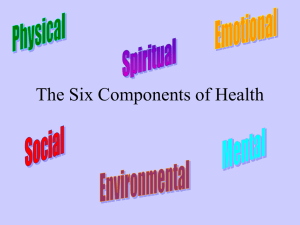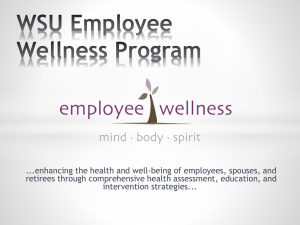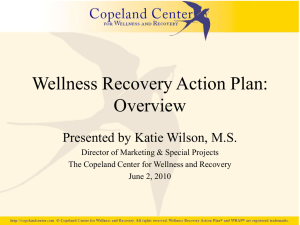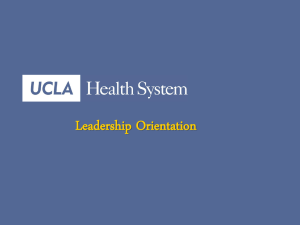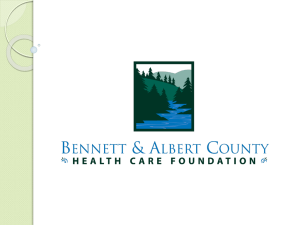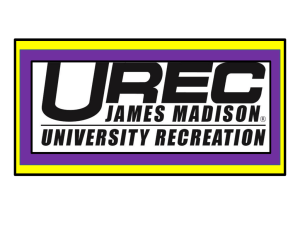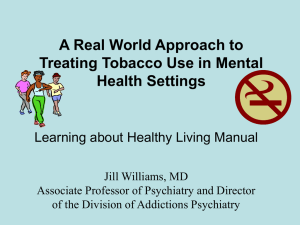Implementing Workplace Wellness Programs that get Results
advertisement
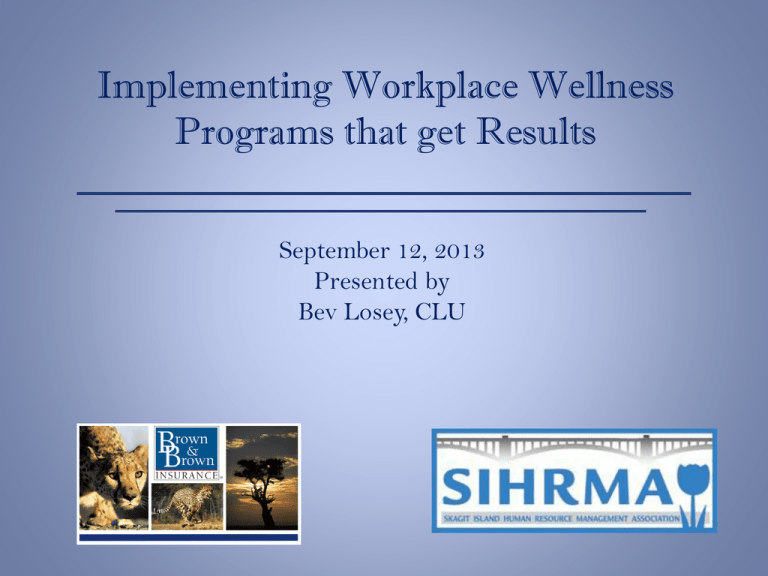
Implementing Workplace Wellness Programs that get Results September 12, 2013 Presented by Bev Losey, CLU Today’s Topics • Why Workplace Wellness – The Issues • “How-to” in Workplace Wellness • Examples of Workplace Wellness Committee Work • Who are the Players • Workplace Wellness integration Workplace Wellness is “an organized, employer – sponsored program that is designed to support employees (and sometimes, their families) as they adopt and sustain behaviors that reduce health risks, improve quality of life, enhance personal effectiveness, and benefit the organization’s bottom line.” Harvard Business Review What factors influence a decision to implement a workplace wellness program? Source: Zywave 2012 Wellness Benefits Survey. Health Care and Its Costs • PwC projects average health care cost increase of 7.5% in 2013: more than three times US inflation and economic growth • Obesity costs $1429 per year according to National Health Institute (structural impact) • Smoking was next highest cost driver; Responsible for 1 in 5 deaths annually; $193B costs in lost productivity and $96B in healthcare costs per Wellnet/Limeade • Stress at work – affects likelihood of heart attack according to University College London • Gail Christopher, Ph.d. , September 10, 2012 annual National Benefits Expo – unhealthy weight gain = adipose tissue = higher risk of 37 different chronic conditions • Recent Kellogg Foundation study reported: 1) Area of brain tissue that controls stress shrinks with high blood sugar 2) High blood pressure can lead to actual loss of brain tissue • Sitting at a desk all day = 1 1/2 packs of cigarettes per Kellogg Foundation • Obesity cost calculator from CDC; www.cdc.gov/leanworks/costcalculator/index.html Health Care and Its Costs Absenteeism: • Unhealthy workers’ absenteeism cost employers more than $153 billion in lost productivity every year.* • Every day an employee calls in sick, it cost the average employer $341 per missed day. • 38% of all absences are related to health issues.** * Source: Callup-Healthways Well-Being Index 2011. ** Source: Ann Hewitt – Senior VP of national absence management consulting practice leader, 2013. Workplace Wellness ROI • Sept 15 Case Study – AMSEC; since May 2009, Weight Watchers at Work – 68 lost 2000 pounds and reported more energy, more stamina and reduced meds • Recent Texas A&M study reports ROI as high as 6:1 • American Journal of Health Promotion (AJHP) reports • 27% reduction in sick leave absenteeism • 26% reduction in health costs • 32% decrease in workers compensation and disability claims • Chief Medical Officer for Thomson Reuters –says Companies who focus in health have better stock prices, out performed the DOW Jones over five years • Compare a Flu shot cost against average ER visit of $1500 (September, per CDC) • Chrysler’s “We Got Your Back” program – 100 participants shown muscle relaxation techniques etc., 55% pain free vs. 100 Beta’s only 5% pain free with Physical Therapy • Mercer national survey found 2% less cost increases, on average with health emphasis • AJHP – reports on results with 20,000 participants 2.45:1 over 3 years • Metlife/Hyatt Legal report 43% of employees who did not hire an attorney for help said physical and emotional health negatively affected Workplace Wellness ROI The Return on Investment (ROI) is clear. ROI for implementing health improvement programs is an average of $5.50 savings in absenteeism and medical costs. These eight MODIFIABLE behaviors cause these 15 conditions which drive 80% of the chronic illness costs: Modifiable Behaviors 1. Smoking 2. Physical inactivity 3. Poor diet 4. Poor standard of care compliance 5. Insufficient sleep 6. Lack of health screening Source: The World Economic forum : The New Discipline of Workforce Wellness. Enhancing Corporate Performance by Tackling Chronic Disease” 2010. Conditions 1. Diabetes 2. Coronary artery disease 3. Hypertension 4. Dyslipidemia 5. Obesity 6. Asthma 7. Arthritis 8. Sinutitus 9. Heart failure 10. COPD 11. Chronic kidney disease 12. Depression 13. Back pain Workplace Wellness ROI Considerations • Not Immediate – Year 1: Diagnosis and Treatment Plan Year 2: Awareness and Change Year 3: Improving Outcomes • Need a healthy dose of reality and set the expectation that there is no instant cure • Avoid Common Wellness Program Pitfalls: • Checking the box • Using a “Scarlet Letter” strategy • Taking a “Robots R Us” approach • Trying for a quick fix • Doing nothing Workplace Wellness Roadmap 7 Best Practices for Building a Wellness Program 1. Get senior level support. Successful wellness programs start at the top. 2. Form a wellness team. Creating a culture of health takes passionate leadership from all levels of the organization. 3. Use data to drive wellness initiatives. Employers often struggle with what wellness initiatives have to offer. A survey, assessment checklist, and health risk appraisal approach guides employers where to focus your efforts. 4. No program is successful without a plan. Develop an annual workplace wellness operating plan, starting with a vision statement. 5. Choose appropriate health initiatives. Collecting data will help you decide what wellness initiatives to promote. Note a variety of lower cost resources and activities exist. 6. Create a corporate environment that supports wellness. Support a culture of health, from top to bottom and bottom to top. 7. Evaluate the outcome of workplace wellness initiatives. Determine what works and what doesn’t so you can plan for the next year. Note: www.shrm.org/templatestools/howtoguides/howtoestablishandesignawellnessprogram Workplace Wellness Resources • General Resources • Wellness Vendors • Wellness Apps Workplace Wellness Innovations • Instant Recess; Tool kit at www.keenfootwear.com • Nap pods – is nap time next? • www.lumoback.com – monitors posture for back pain • www.eligible.com – to navigate the healthcare system • www.betterdoctor.com – San Francisco pilot • www.realmealz.com – nutrition team challenges • www.gohealthhero.com – health game integrated with Facebook • www.fitbit.com – movement tracking device Instant Recess Who are the Players? • C- Suite; Senior leadership • Wellness committee/team; all employees • Legal considerations • Community • Insurers • Broker/Consultant • Wellness vendors Gaining Senior Leadership Support • A commitment from the top is critical to the success of any wellness initiative • Management must understand the benefits of the program for both the employees and the organization • Be willing to commit sufficient funding and/or time • Link health promotion to business goals, values and strategic priorities • Emphasize improved employee productivity and health care cost savings Management’s attitude towards wellness falls into one of five categories: • Active Opposition • Quiet Opposition • Neutral • Quiet Supporters • Wellness Champions Developing a Wellness Team • Formally appoint team members and a leader • Promote the wellness team within the organization • Include employees from all levels and areas of the organization • If multi-location, name a Wellness Champion per worksite • Meet on a regular schedule with a formal agenda • Communication is the key Find Your Wellness Breathing Energy into a Wellness Team • • • • • • • • • Recruit the CEO or another influential executive to sit in on a wellness meeting A team name, vision and tagline provide a sense of identity and motivation Continually recruit new team members who are natural leaders Share the stories of employees who have experienced successful individual results Assess the individual strengths of each team member Set goals for the team to achieve Publishing a team newsletter creates a sense of pride and outlines the efforts of the wellness initiatives Take the team on a retreat as a way of regrouping and recharging their energy Continue wellness education by bringing in outside resources Legal Considerations • • • • ADA – Americans with Disabilities Act; safe harbor HIPAA – 20% of total premium as margin; no PHI to group DOL – nondiscrimination regulations EPL – Employment Practices Liability; not for hiring, retention, performance evaluations, and promotions • ERISA and COBRA – Stand alone program to be “valued” for COBRA • PPACA – 30% in 2014; 50% for tobacco; small business grants • PPACA – Final regulations issued May 29, 2013 • Participating programs • Activities only programs • Outcome-based programs • Uniform availability and reasonable alternatives Community Events and Learning Opportunities • • • • • • • • • • • • • • • • Art and Science of Health Promotion Conference (March 24 - 28, 2014) SHRM: Health Benefit Strategy; leveraging Data, Design and Wellness – June 22 – 25, 2014 Mid-Sized Retirement & Healthcare Plan Management Conference; September 15 – 18, 2013 Wellness in the Workplace conference; September 11, 2013 IF Annual Employee Conference; October 20 – 23, 2013 Health 2.0; September 29, 2013 Heart & Stroke Walks; October 5, 2013 (South Sound) and October 26, 2013 (Puget Sound) Be Well Washington; A Family Health Week Fair; October 12, 2013 Healthy Worksite Summit; Washington State Department of Health (Lynnwood); October 2 – 3, 2013 National Eating Healthy Day; November 6, 2013 Local Public Health Departments Local Chapters: AHA, ACS, ADA, COPD, SHRM Health Fair resources: nutritionists, YMCA, insurers, massage therapists, dentists; flu shots (RiteAid - $29.99) Health Care System materials; Broker/Consultant materials and guidance Workplace Integration • Activities committee • Safety committee • Community Involvement committee • Communications • Insurance/Benefits plans Insurance/Benefits Plans • Health Plans • Primary Care Carveout • Onsite/Near site clinics • CDHP’s • VBID/VBBD’s • Preventive Care • Flu shots • Health Risk Assessment/Biometrics • Fitness Networks/Discounts • Dental plan • Employee Assistance Plan • 401(K), retirement plan; life plan • STD/Sick leave/PTO/LTD plan Incentives Types • • • • • • • • • Wellness dollars Monetary rewards Contests Achievement awards Public recognition Food Time Off Discounts Premium Reductions Behaviors • • • • • Health risk assessments Participation (variations) Individual achievements Smoking cessation classes Biometric accomplishments • Multiple behaviors • Invite family members Trend: Looking to Incent Outcomes/Results versus Behaviors. Ten Motivational Styles Find the leadership mode that will best inspire each employee: • • • • • Goal setter Fun follower Social connector Helper/Giver Reward earner • • • • • Competitor Active learner Achiever Purpose seeker Structure seeker Source: The Healthiest You Program Remember to appeal to a variety of generations, ethnicities, Socioeconomic and education levels, and gender; i.e. customization works. Sample Communications Campaigns • • • • • • • • Employee Retirement Campaign Family Health Series Campaign Health Costs Employee Education Campaign National Health Observance Calendar Campaign Live Well, Work Well Monthly Newsletter Campaign Prevention Newsletter Campaign Seasonal Campaign Wellness Program Campaign Communication “Do’s” • • • • • Make it entertaining and create some buzz Appeal to what’s important to employees Make it easy Make me feel part of a community Branded with an annual theme Customizing to the Individual Bev as Example: • • • • • • • • • • • • • • • • B & B Incentive for HRA completion (prior year for biometrics) BCBS of Florida – My Personal Wellness Portal B & B Employee Assistance Plan B-Fit! Wellness Activities National Healthy Worksite Program for B & B – Tacoma South Beach Daily Diet Newsletter Gratefulness.org; Word for the Day Fit Bit – Weekly Reports YMCA Membership Farmers Market – fresh produce weekly Island walks Gardening Reading Bubble baths Joy Journal Massages (when I can get ‘em) “To stumble is not to fall but to move forward faster.” -African Proverb Questions?
